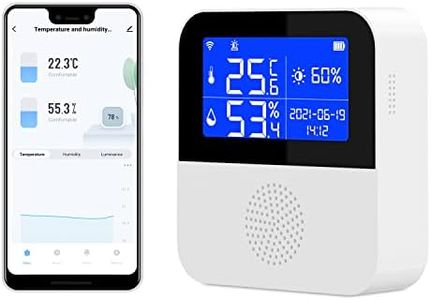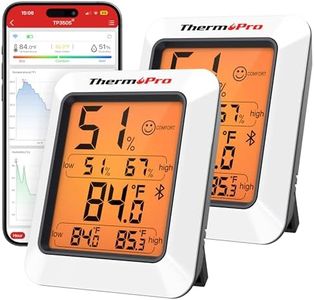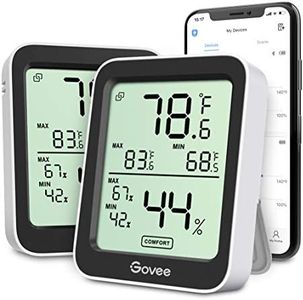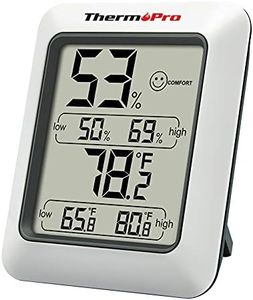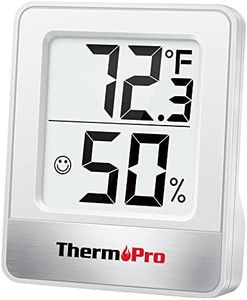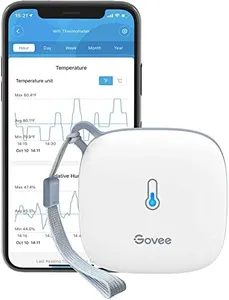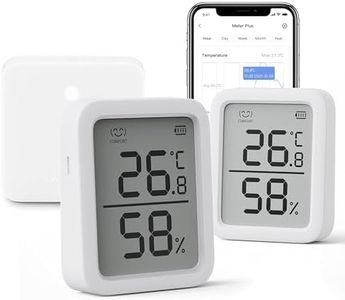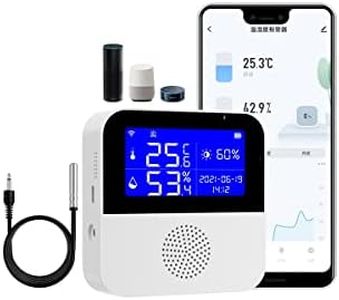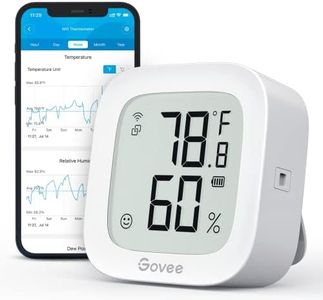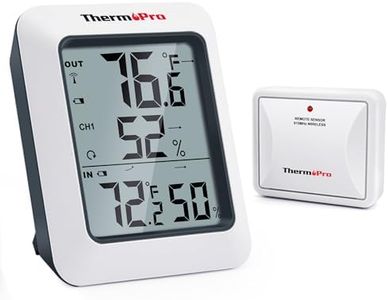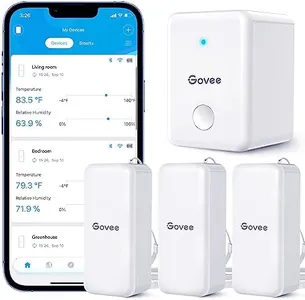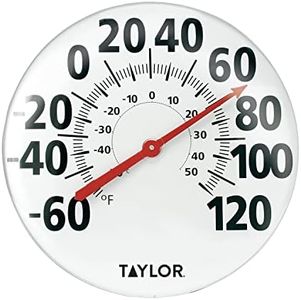10 Best Indoor Thermometers 2025 in the United States
Our technology thoroughly searches through the online shopping world, reviewing hundreds of sites. We then process and analyze this information, updating in real-time to bring you the latest top-rated products. This way, you always get the best and most current options available.

Our Top Picks
Winner
ThermoPro Hygrometer Thermometer for House TP350, Bluetooth Room Indoor Greenhouse Thermometer Monitor Up to 260FT, Backlit Humidity Meter Temperature Sensor with 2-Year Data Export, 2 Pack
Most important from
150647 reviews
The ThermoPro Hygrometer Thermometer TP350 is designed for indoor use and excels in several key areas. It boasts high accuracy with a temperature precision of +/-0.9°F and a humidity accuracy of +/-2% RH, making it reliable for maintaining desired environmental conditions. The device refreshes data every 10 seconds, ensuring timely updates. Its Bluetooth connectivity allows users to monitor conditions from up to 260 feet away via the ThermoPro app, which does not require registration, enhancing user privacy.
The thermometer also offers a substantial 2-year data storage and export feature, beneficial for tracking long-term environmental changes. Its large, backlit display is easy to read in low light, and a comfort indicator icon provides at-a-glance insights into the room's conditions. The device is versatile, suitable for various settings such as bedrooms, baby rooms, and cigar rooms. It is powered by two AAA batteries, which are included.
While the product is highly rated and widely used, it may not be suitable for those seeking an advanced smart home integration experience, as it relies primarily on Bluetooth connectivity. The compact size and multiple mounting options (tabletop, surface mount, hanging) add to its convenience. The ThermoPro TP350 is a solid choice for users needing accurate and easy-to-read temperature and humidity monitoring for indoor environments.
Most important from
150647 reviews
Govee Bluetooth Hygrometer Thermometer, Large LCD, Max/Min Records, 2-Year Data Storage - Black, 2 Pack
Most important from
44602 reviews
The Govee Bluetooth Hygrometer Thermometer is an effective tool for monitoring indoor temperature and humidity. Its standout feature is the Swiss-made sensor, providing highly accurate measurements with a ±0.54°F variance for temperature and ±3%RH for humidity. The large LCD display makes it easy to read the current conditions, and the max/min records offer a quick overview of fluctuations. The device updates data every 2 seconds, ensuring you always have the latest information.
The Bluetooth connectivity works up to 196 feet, which is convenient for receiving alerts via the Govee Home app when conditions go outside preset ranges. This feature is especially handy for monitoring multiple areas like homes, garages, nurseries, wine cellars, or basements. The 2-year data storage and the ability to export data in CSV format are excellent for those who need detailed historical records.
However, the reliance on 4 AAA batteries might be seen as a drawback for those who prefer rechargeable options or fewer battery changes. The plastic material is durable but may not appeal to everyone aesthetically. The device's ease of use, aided by the app, makes it accessible for all age ranges from adults to kids. While it excels in providing accurate, real-time data, it might not be the best choice for someone looking for a thermometer with a broader temperature range beyond typical indoor environments.
Most important from
44602 reviews
ThermoPro TP50 Digital Hygrometer Indoor Thermometer Room Thermometer and Humidity Gauge with Temperature Monitor
Most important from
150646 reviews
The ThermoPro TP50 Digital Hygrometer Indoor Thermometer is highly accurate, with measurements precise to within +/- 2 to 3% relative humidity and +/- 1°F, making it reliable for indoor use. The display updates every 10 seconds, ensuring you have the most current data. This rapid response time is beneficial for environments where conditions change quickly, such as greenhouses or reptile enclosures.
The thermometer covers a wide temperature range, up to 158°F, suitable for various applications, including kitchens and cellars. The Air Comfort Indicator visually shows if the air is dry, comfortable, or wet, which can be very helpful for maintaining a healthy indoor environment. High and low records display allows for easy monitoring and comparison of temperature and humidity over time. The thermometer is versatile in placement with options to stand it on a tabletop, attach it magnetically, or hang it.
It is powered by a single AAA battery (included), making it convenient and easy to set up right out of the box. However, the small display may be difficult to read from a distance and might not be suitable for those with poor eyesight. The reliance on battery power also means you need to keep spare batteries handy. This product is an excellent choice for anyone needing a reliable, versatile indoor thermometer and humidity gauge, such as homeowners, gardeners, or those with specific climate control needs like musicians or reptile owners.
Most important from
150646 reviews
Buying Guide for the Best Indoor Thermometers
Choosing the right indoor thermometer can greatly enhance your comfort and health by providing accurate temperature readings for your living space. When selecting an indoor thermometer, it's important to consider several key specifications to ensure you get the best fit for your needs. Understanding these specifications will help you make an informed decision and find a thermometer that meets your requirements.FAQ
Most Popular Categories Right Now
